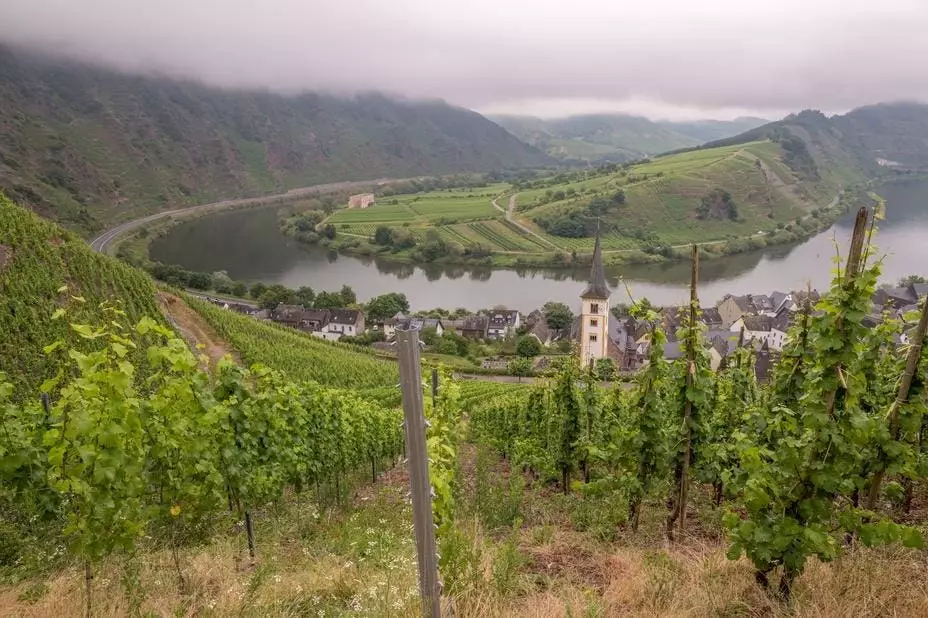Nestled amongst the undulating hills and lush landscapes of Germany, the Mosel Valley shines as a beacon for wine enthusiasts, particularly lovers of Riesling. On a June day, the warmth of the sun pours over the slopes, drawing attention to a unique aspect of viticulture: the strategic placement of vineyards in seemingly harsh conditions. Observing the steep inclines, one might wonder: what drives winemakers to cultivate grapes on land so challenging? Yet, the answer lies in the very attributes that make the Mosel an enchanted region for wine production—its climatic uniqueness and geological inheritance granting it character and complexity.
The Mosel Valley is geographically distinguished by its soaring hills, serpentine river bends, and volcanic slate soils interspersed with quartzite. This environment creates a microclimate that favors the cultivation of Riesling grapes, allowing them to achieve a remarkable balance of high acidity and natural sugars. “There is a magic element to Riesling production here,” notes Valerie Kathawala, a seasoned wine journalist. “The interplay of steep slopes, diverse exposures, and soil types creates an environment that is both nurturing and challenging for the grapes, resulting in wines with distinct integrity and flavor profiles.”
The region’s climate further enhances the growth cycle of Riesling. With longer growing seasons, the grapes can develop full ripeness while retaining their acidity, creating wines that are refreshing and vibrant. This delicate equilibrium is what numerous winemakers strive for—a hallmark of the Mosel’s refined Rieslings.
Riesling’s storied past within the Mosel begins as early as 1435, accumulating prestige and desirability over the centuries. By the 17th century, this varietal had solidified its reputation, becoming the region’s flagship. What initially captivated noble palates with its sweetness has evolved, highlighting advancements in viticulture and changing consumer preferences. During and after World War II, American soldiers paved the way for sweeter wines, influencing the tastes of a generation.
However, the contemporary winemaking philosophy differs markedly from this historical trend. Many modern Riesling producers are shedding the sugary persona of their predecessors, turning to the drier, crisper styles that showcase the grape’s inherent acidity. “Today’s growers aim to revisit the original essence of Riesling, which is remarkably versatile,” states Sophia Thanisch, a fourth-generation winemaker. As younger vintners embrace ancestral techniques, the Mosel region finds itself on the cusp of a vibrant renaissance, as they infuse traditional practices with innovative approaches.
As the Mosel matures in its wine production, a noteworthy collaboration emerges among the vineyard owners and winemakers. This cooperative mindset fosters a healthy environment where good practices are shared, creating a supportive community dedicated to producing quality wines. The emphasis on sustainable, organic, and biodynamic methods is becoming a standard, and families such as the Thanischs are committed to enhancing their vineyards’ ecological balance.
“Understanding that the soil speaks to the wine is critical,” shares Christopher Loewen from Weingut Carl Loewen. By prioritizing viticulture first, winemakers concentrate on ensuring the health of the vineyards before focusing on the wine in the cellar. The resulting wines not only reflect the site-specific terroir but also offer a narrative that tells the story of the land itself.
Truly appreciating Mosel Riesling requires some knowledge, as the variations in sweetness can bewilder even the most discerning wine aficionados. Several producers have adopted color-coded labeling systems to indicate sweetness levels, while others maintain a more intuitive approach, encouraging drinkers to explore wines based on personal preferences rather than simply numerical designations.
The challenge, however, is worth undertaking; the flexibility of Riesling allows it to pair exquisitely with a plethora of dishes. “The joy of discovering Mosel Riesling lies in its diversity,” Kathawala notes. “Every experience uncovers new layers and textures, making each glass an invitation to adventure.”
With its breathtaking vineyards, rich cultural heritage, and passionate new generation of winemakers, the Mosel Valley stands out as a paradise for Riesling. As the region embraces lower intervention styles and revives traditional methods, it solidifies its place among the world’s most eminent wine-producing locales. “Mosel Riesling truly is an exploratory journey,” emphasizes Kathawala. “With endless possibilities and an encouraging community of producers, it is astonishing that these treasures are not more widely recognized.” As wine lovers seek exceptional experiences, the Mosel Valley awaits, offering the perfect blend of history, craftsmanship, and nature’s artistry in every bottle.


Leave a Reply